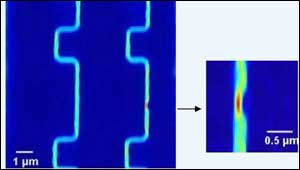This topic covers issues related to energy generation, conversion, transportation and consumption and how the industry is addressing the challenge of energy efficiency in general.
innovations-report provides in-depth and informative reports and articles on subjects ranging from wind energy, fuel cell technology, solar energy, geothermal energy, petroleum, gas, nuclear engineering, alternative energy and energy efficiency to fusion, hydrogen and superconductor technologies.

Ohio University engineers are leading one of the first comprehensive efforts to examine how fuel cell technology could pave the way for cleaner coal-fired power plants. Supported by a $4 million U.S. Department of Energy grant secured by the Ohio Congressional delegation, the project aims to find ways to use coal – the environmentally dirtiest but most abundant fossil fuel in the world — to harness high-efficiency fuel cells.
Most government-sponsored energy research is focused on using nat

The world’s oceans hold the key to our future electricity needs. And their potential for producing power has yet to be fully exploited in terms of sustainable energy. The EUREKA WWEC project team hopes to bring exploitation of this renewable energy source a big step forward.
“We’ve developed a device that generates energy from the sea as easily as a wind turbine would do on land,” explains William Dick, managing director of the Irish company Wavebob that led the project. “There’s an awful lo

A new scanning microscope developed at Brown University can uncover defects in the smallest and most complex integrated circuits at a resolution 1,000 times greater than current technology. The scanner removes a barrier to further shrinking of integrated circuits: As circuits get smaller, non-visual defects become harder to find.
“This microscope will allow manufacturers to find defects in each embedded wire in ever-tinier circuits,” said Brown University professor Gang Xiao. He developed th

Thermography provides the easy checking of points throughout an electric system where faults may arise, and with sufficient warning in order to correct the fault before things get worse.
Infrared thermography provides the visualisation of temperature differences arising at the surfaces of objects. The tool used is a portable and autonomous camera (similar to a home video camera) which is equipped with a detector which permits the measurement and visualisation of thermal images.
Th

A new type of very thin solar cell made from inexpensive materials has been invented by researchers at the Hahn Meitner Institute in Berlin, Germany, in collaboration with a colleague now at Portland State University, Oregon, USA. The new device will be much cheaper to make because it uses less expensive semiconductor materials than conventional solar cells. The researchers publish details of their invention in the Institute of Physics journal Semiconductor Science & Technology on 14 April 2003.

Computer Simulations Provide Insight On Light Degradation Effect in Solar Cells
Scientists at the U.S. Department of Energy’s Ames Laboratory and Iowa State University’s Microelectronics Research Center may have solved a mystery that has plagued the research community for more than 20 years: Why do solar cells degrade in sunlight? Finding the answer to that question is essential to the advancement of solar cell research and the ability to produce lower-cost electricity from